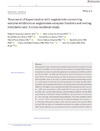Identificador persistente para citar o vincular este elemento:
https://accedacris.ulpgc.es/jspui/handle/10553/123869
| Título: | Treatment of hypertension with angiotensin-converting enzyme inhibitors or angiotensin receptor blockers and resting metabolic rate: A cross-sectional study | Autores/as: | Pedrianes Martín, Pablo Benito Martín Rincón, Marcos Morales Álamo, David Pérez Suárez, Ismael Pérez Valera, Mario Galván Álvarez, Víctor Curtelin, David de Pablos-Velasco, Pedro Calbet, José A.L. |
Clasificación UNESCO: | 241106 Fisiología del ejercicio | Palabras clave: | Angiotensin Exercise Obesity Overweight Resting energy expenditure, et al. |
Fecha de publicación: | 2021 | Proyectos: | Viabilidad y sostenibilidad del adelgazamiento mediante tratamiento intensificado en pacientes con sobrepeso u obesidad: mecanismos neuroendocrinos y moleculares Estudio longitudinal de los efectos de una modificación intensiva del estilo de vida en la composición corporal e indicadores bioquímicos y moleculares de salud en pacientes con sobrepeso y obesidad: aplicación para la evaluación fisiológica de rutas y sistemas de monitorización del esfuerzo ... Integracion de Los Grupos de la Obesidady El Síndrome Metabólico .... (Estructurante-4.- Campo: Medicinay Salud) |
Publicación seriada: | Journal of Clinical Hypertension | Resumen: | Hypertension in obese and overweight patients is associated with an elevated resting metabolic rate (RMR). The aim of this study was to determine whether RMR is reduced in hypertensive patients treated with angiotensin-converting enzyme inhibitors (ACEI) and blockers (ARB). The RMR was determined by indirect calorimetry in 174 volunteers; 93 (46.5 %) were hypertensive, of which 16 men and 13 women were treated with ACEI/ARB, while 30 men and 19 women with untreated hypertension served as a control group. Treated and untreated hypertensives had similar age, BMI, physical activity, and cardiorespiratory fitness. The RMR normalized to the lean body mass (LBM) was 15% higher in the untreated than ACEI/ARB-treated hypertensive women (p = .003). After accounting for LBM, whole-body fat mass, age, the double product (heart rate x systolic blood pressure), and the distance walked per day, the RMR was 2.9% lower in the patients taking ACEI/ARB (p = .26, treatment x sex interaction p = .005). LBM, age, and the double product explained 78% of the variability in RMR (R2 = 0.78, p < .001). In contrast, fat mass, the distance walked per day, and total T4 or TSH did not add predictive power to the model. Compared to men, a greater RMR per kg of LBM was observed in untreated hypertensive overweight and obese women, while this sex difference was not observed in patients treated with ACEI or ARBs. In conclusion, our results indicate that elevated RMR per kg of LBM may be normalized by antagonizing the renin-angiotensin system. | URI: | https://accedacris.ulpgc.es/handle/10553/123869 | ISSN: | 1524-6175 | DOI: | 10.1111/jch.14392 | Fuente: | Journal of Clinical Hypertension [ISSN 1524-6175], v. 23 (12), p. 2106-2114, (Diciembre 2021) |
| Colección: | Artículos |
Citas SCOPUSTM
2
actualizado el 08-jun-2025
Citas de WEB OF SCIENCETM
Citations
2
actualizado el 08-jun-2025
Visitas
32
actualizado el 13-ene-2024
Descargas
7
actualizado el 13-ene-2024
Google ScholarTM
Verifica
Altmetric
Comparte
Exporta metadatos
Los elementos en ULPGC accedaCRIS están protegidos por derechos de autor con todos los derechos reservados, a menos que se indique lo contrario.
